Great Migration: Causes, Risks, and Impact on American Society (Essay)
VerifiedAdded on 2020/05/16
|5
|1106
|662
Essay
AI Summary
This essay provides a comprehensive overview of the Great Migration, a pivotal period in American history marked by the movement of African Americans from the rural South to the North, Midwest, and West. The essay delves into the causes of this migration, including the devastation caused by the Boll weevil, labor shortages during World War I, and racial discrimination. It distinguishes between the first and second Great Migrations, outlining the distinct factors that fueled each. The essay also examines the risks faced by migrants, such as low wages, social challenges, and potential health hazards. Furthermore, it analyzes the impacts of the migration, including increased mortality rates in the North, the implementation of the Fair Employment Practice Committee, and the social unrest and riots that arose. The essay concludes by highlighting the transformative impact of the Great Migration on the United States, emphasizing its profound and lasting effects on both the migrated communities and the nation as a whole.
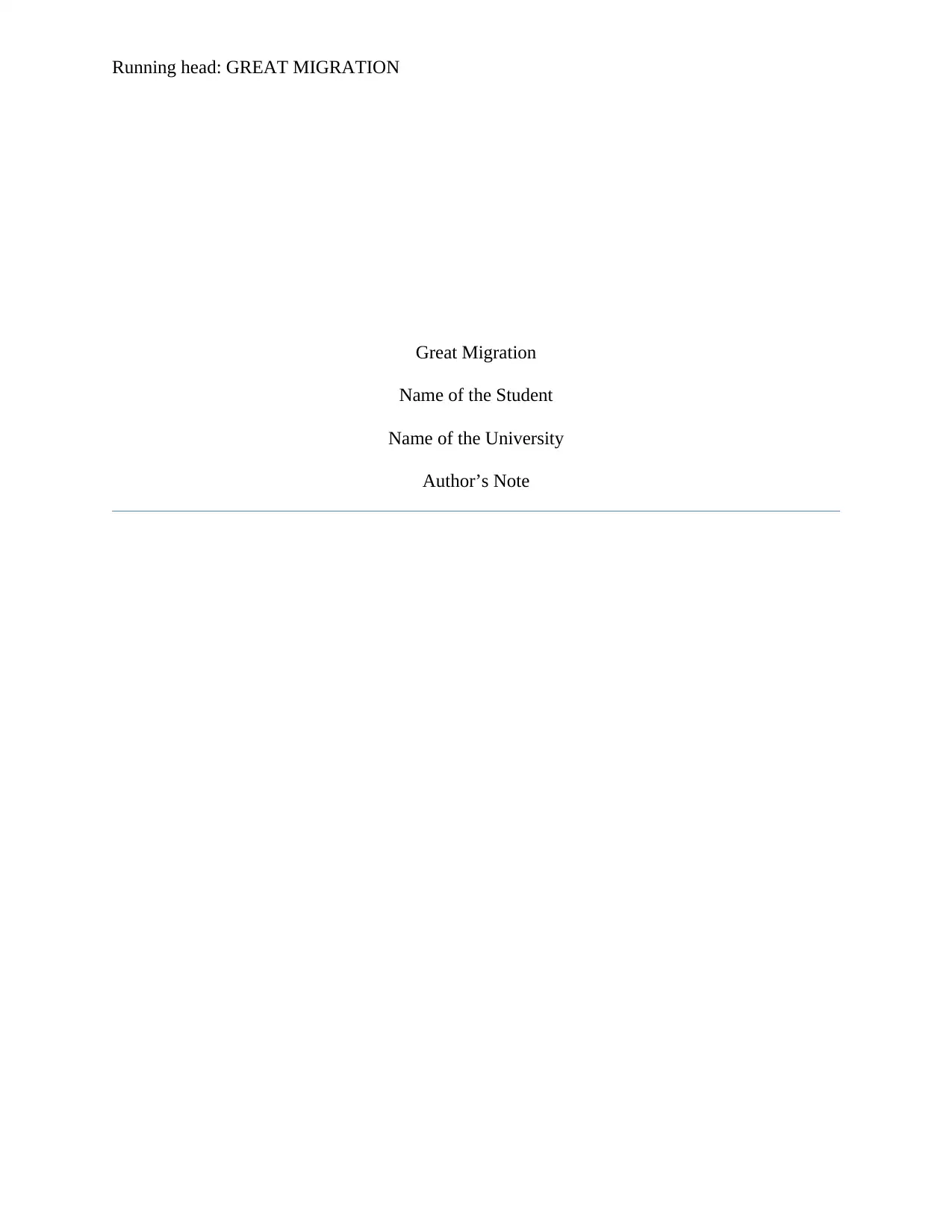
Running head: GREAT MIGRATION
Great Migration
Name of the Student
Name of the University
Author’s Note
Great Migration
Name of the Student
Name of the University
Author’s Note
Paraphrase This Document
Need a fresh take? Get an instant paraphrase of this document with our AI Paraphraser
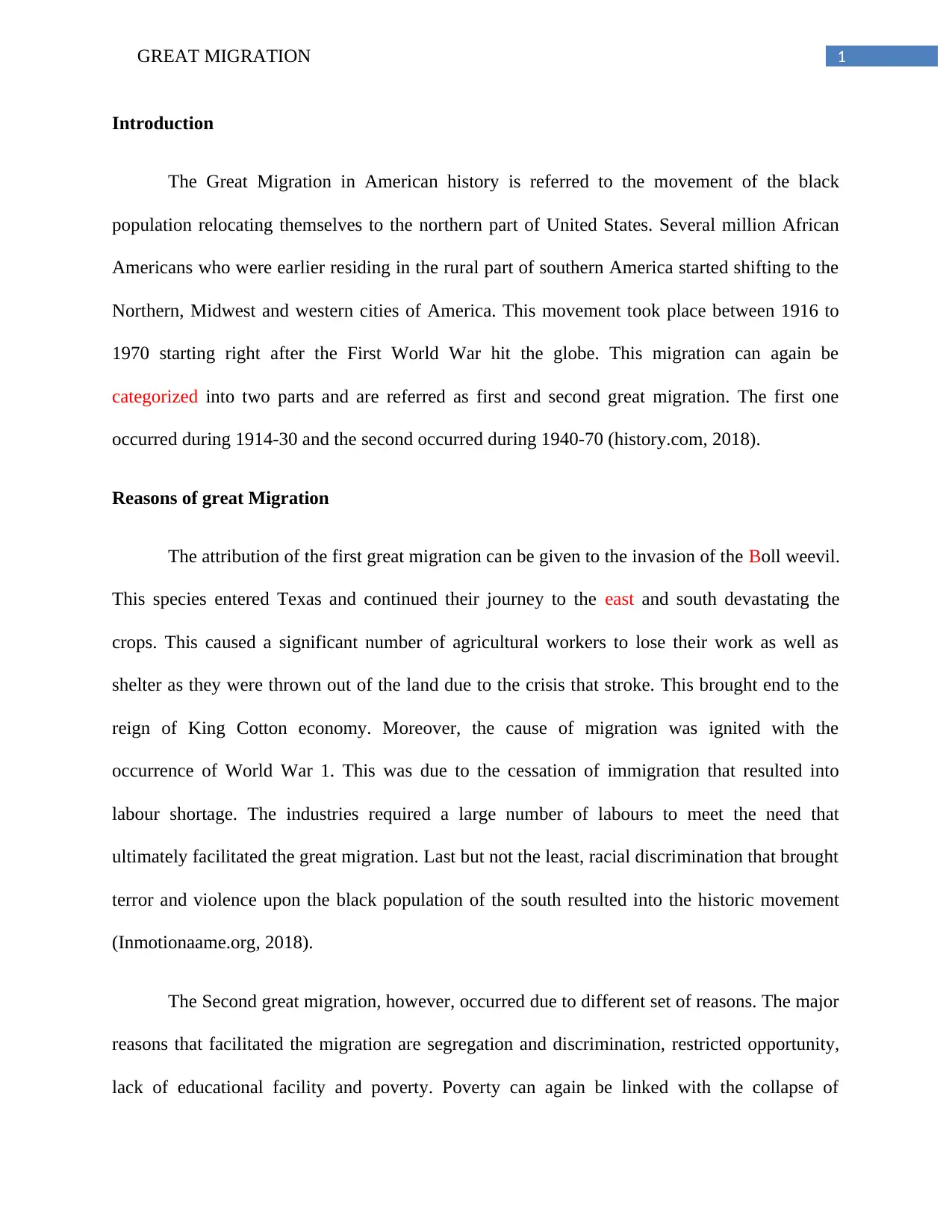
1GREAT MIGRATION
Introduction
The Great Migration in American history is referred to the movement of the black
population relocating themselves to the northern part of United States. Several million African
Americans who were earlier residing in the rural part of southern America started shifting to the
Northern, Midwest and western cities of America. This movement took place between 1916 to
1970 starting right after the First World War hit the globe. This migration can again be
categorized into two parts and are referred as first and second great migration. The first one
occurred during 1914-30 and the second occurred during 1940-70 (history.com, 2018).
Reasons of great Migration
The attribution of the first great migration can be given to the invasion of the Boll weevil.
This species entered Texas and continued their journey to the east and south devastating the
crops. This caused a significant number of agricultural workers to lose their work as well as
shelter as they were thrown out of the land due to the crisis that stroke. This brought end to the
reign of King Cotton economy. Moreover, the cause of migration was ignited with the
occurrence of World War 1. This was due to the cessation of immigration that resulted into
labour shortage. The industries required a large number of labours to meet the need that
ultimately facilitated the great migration. Last but not the least, racial discrimination that brought
terror and violence upon the black population of the south resulted into the historic movement
(Inmotionaame.org, 2018).
The Second great migration, however, occurred due to different set of reasons. The major
reasons that facilitated the migration are segregation and discrimination, restricted opportunity,
lack of educational facility and poverty. Poverty can again be linked with the collapse of
Introduction
The Great Migration in American history is referred to the movement of the black
population relocating themselves to the northern part of United States. Several million African
Americans who were earlier residing in the rural part of southern America started shifting to the
Northern, Midwest and western cities of America. This movement took place between 1916 to
1970 starting right after the First World War hit the globe. This migration can again be
categorized into two parts and are referred as first and second great migration. The first one
occurred during 1914-30 and the second occurred during 1940-70 (history.com, 2018).
Reasons of great Migration
The attribution of the first great migration can be given to the invasion of the Boll weevil.
This species entered Texas and continued their journey to the east and south devastating the
crops. This caused a significant number of agricultural workers to lose their work as well as
shelter as they were thrown out of the land due to the crisis that stroke. This brought end to the
reign of King Cotton economy. Moreover, the cause of migration was ignited with the
occurrence of World War 1. This was due to the cessation of immigration that resulted into
labour shortage. The industries required a large number of labours to meet the need that
ultimately facilitated the great migration. Last but not the least, racial discrimination that brought
terror and violence upon the black population of the south resulted into the historic movement
(Inmotionaame.org, 2018).
The Second great migration, however, occurred due to different set of reasons. The major
reasons that facilitated the migration are segregation and discrimination, restricted opportunity,
lack of educational facility and poverty. Poverty can again be linked with the collapse of
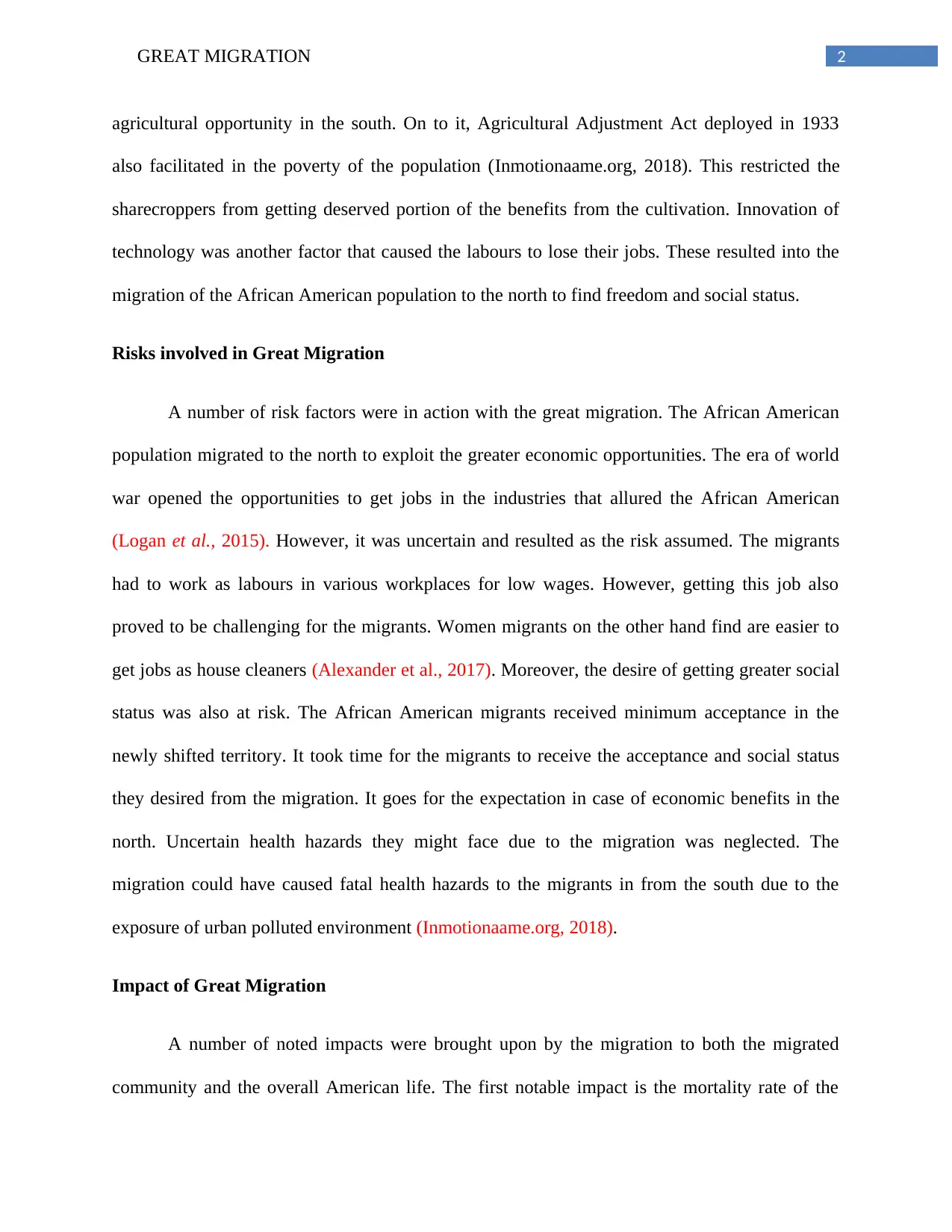
2GREAT MIGRATION
agricultural opportunity in the south. On to it, Agricultural Adjustment Act deployed in 1933
also facilitated in the poverty of the population (Inmotionaame.org, 2018). This restricted the
sharecroppers from getting deserved portion of the benefits from the cultivation. Innovation of
technology was another factor that caused the labours to lose their jobs. These resulted into the
migration of the African American population to the north to find freedom and social status.
Risks involved in Great Migration
A number of risk factors were in action with the great migration. The African American
population migrated to the north to exploit the greater economic opportunities. The era of world
war opened the opportunities to get jobs in the industries that allured the African American
(Logan et al., 2015). However, it was uncertain and resulted as the risk assumed. The migrants
had to work as labours in various workplaces for low wages. However, getting this job also
proved to be challenging for the migrants. Women migrants on the other hand find are easier to
get jobs as house cleaners (Alexander et al., 2017). Moreover, the desire of getting greater social
status was also at risk. The African American migrants received minimum acceptance in the
newly shifted territory. It took time for the migrants to receive the acceptance and social status
they desired from the migration. It goes for the expectation in case of economic benefits in the
north. Uncertain health hazards they might face due to the migration was neglected. The
migration could have caused fatal health hazards to the migrants in from the south due to the
exposure of urban polluted environment (Inmotionaame.org, 2018).
Impact of Great Migration
A number of noted impacts were brought upon by the migration to both the migrated
community and the overall American life. The first notable impact is the mortality rate of the
agricultural opportunity in the south. On to it, Agricultural Adjustment Act deployed in 1933
also facilitated in the poverty of the population (Inmotionaame.org, 2018). This restricted the
sharecroppers from getting deserved portion of the benefits from the cultivation. Innovation of
technology was another factor that caused the labours to lose their jobs. These resulted into the
migration of the African American population to the north to find freedom and social status.
Risks involved in Great Migration
A number of risk factors were in action with the great migration. The African American
population migrated to the north to exploit the greater economic opportunities. The era of world
war opened the opportunities to get jobs in the industries that allured the African American
(Logan et al., 2015). However, it was uncertain and resulted as the risk assumed. The migrants
had to work as labours in various workplaces for low wages. However, getting this job also
proved to be challenging for the migrants. Women migrants on the other hand find are easier to
get jobs as house cleaners (Alexander et al., 2017). Moreover, the desire of getting greater social
status was also at risk. The African American migrants received minimum acceptance in the
newly shifted territory. It took time for the migrants to receive the acceptance and social status
they desired from the migration. It goes for the expectation in case of economic benefits in the
north. Uncertain health hazards they might face due to the migration was neglected. The
migration could have caused fatal health hazards to the migrants in from the south due to the
exposure of urban polluted environment (Inmotionaame.org, 2018).
Impact of Great Migration
A number of noted impacts were brought upon by the migration to both the migrated
community and the overall American life. The first notable impact is the mortality rate of the
⊘ This is a preview!⊘
Do you want full access?
Subscribe today to unlock all pages.

Trusted by 1+ million students worldwide
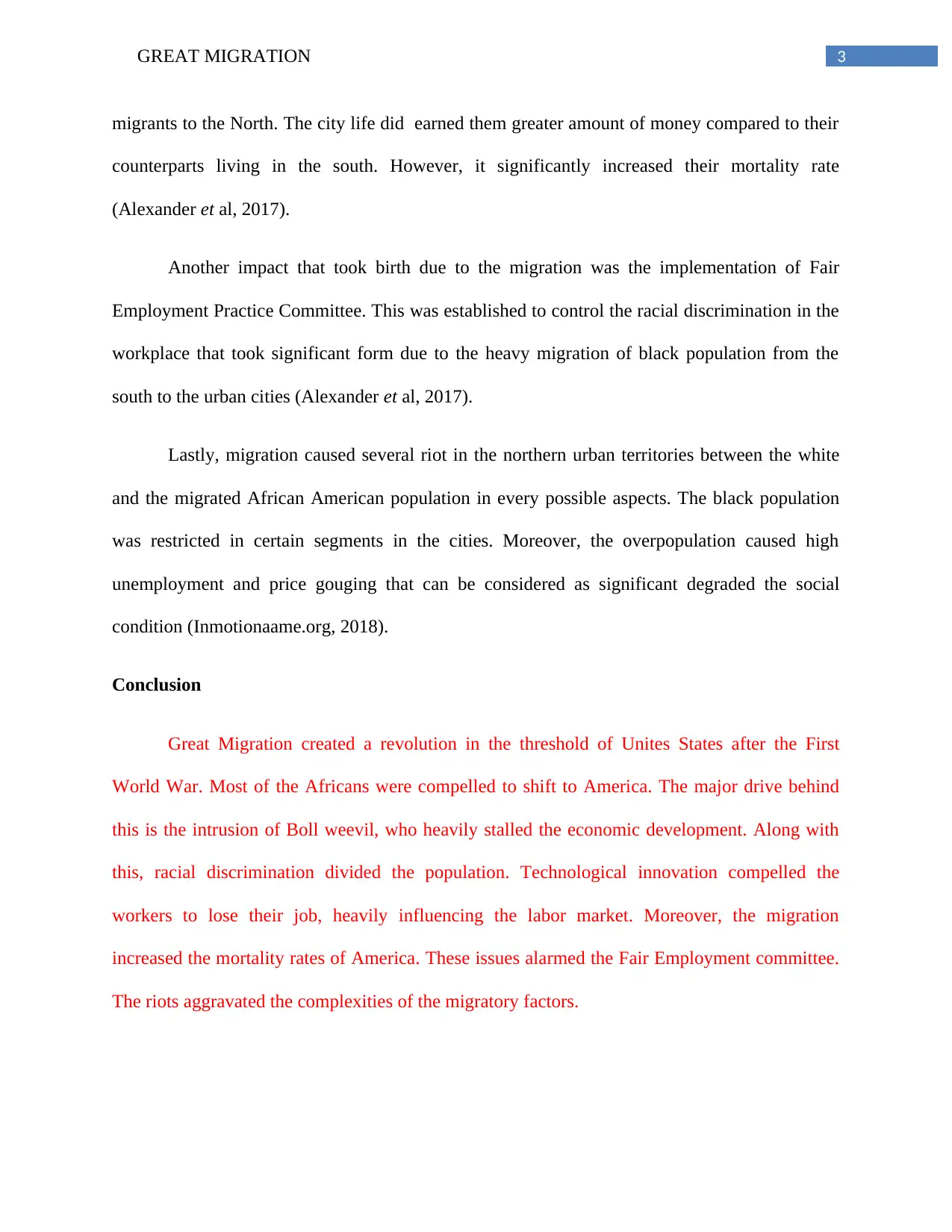
3GREAT MIGRATION
migrants to the North. The city life did earned them greater amount of money compared to their
counterparts living in the south. However, it significantly increased their mortality rate
(Alexander et al, 2017).
Another impact that took birth due to the migration was the implementation of Fair
Employment Practice Committee. This was established to control the racial discrimination in the
workplace that took significant form due to the heavy migration of black population from the
south to the urban cities (Alexander et al, 2017).
Lastly, migration caused several riot in the northern urban territories between the white
and the migrated African American population in every possible aspects. The black population
was restricted in certain segments in the cities. Moreover, the overpopulation caused high
unemployment and price gouging that can be considered as significant degraded the social
condition (Inmotionaame.org, 2018).
Conclusion
Great Migration created a revolution in the threshold of Unites States after the First
World War. Most of the Africans were compelled to shift to America. The major drive behind
this is the intrusion of Boll weevil, who heavily stalled the economic development. Along with
this, racial discrimination divided the population. Technological innovation compelled the
workers to lose their job, heavily influencing the labor market. Moreover, the migration
increased the mortality rates of America. These issues alarmed the Fair Employment committee.
The riots aggravated the complexities of the migratory factors.
migrants to the North. The city life did earned them greater amount of money compared to their
counterparts living in the south. However, it significantly increased their mortality rate
(Alexander et al, 2017).
Another impact that took birth due to the migration was the implementation of Fair
Employment Practice Committee. This was established to control the racial discrimination in the
workplace that took significant form due to the heavy migration of black population from the
south to the urban cities (Alexander et al, 2017).
Lastly, migration caused several riot in the northern urban territories between the white
and the migrated African American population in every possible aspects. The black population
was restricted in certain segments in the cities. Moreover, the overpopulation caused high
unemployment and price gouging that can be considered as significant degraded the social
condition (Inmotionaame.org, 2018).
Conclusion
Great Migration created a revolution in the threshold of Unites States after the First
World War. Most of the Africans were compelled to shift to America. The major drive behind
this is the intrusion of Boll weevil, who heavily stalled the economic development. Along with
this, racial discrimination divided the population. Technological innovation compelled the
workers to lose their job, heavily influencing the labor market. Moreover, the migration
increased the mortality rates of America. These issues alarmed the Fair Employment committee.
The riots aggravated the complexities of the migratory factors.
Paraphrase This Document
Need a fresh take? Get an instant paraphrase of this document with our AI Paraphraser
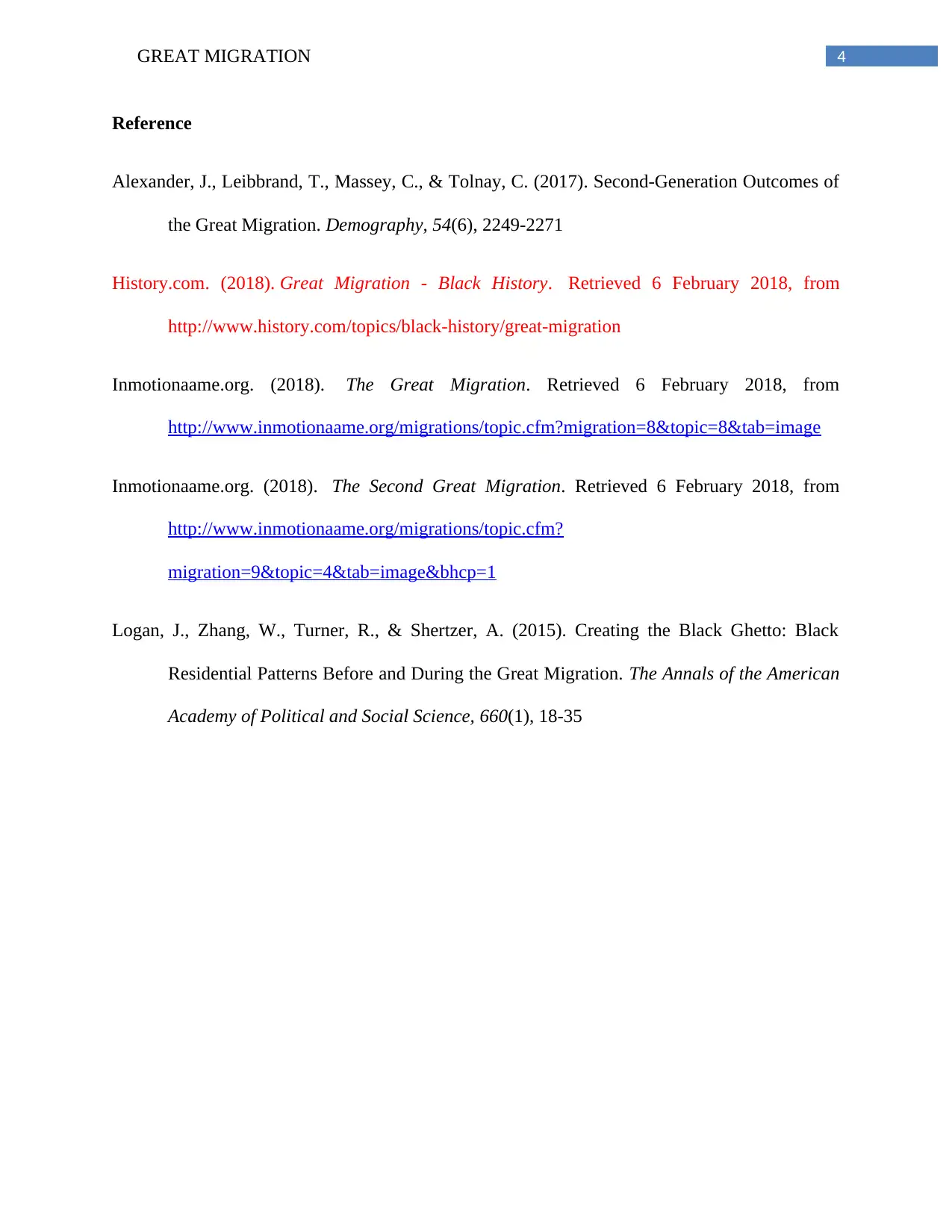
4GREAT MIGRATION
Reference
Alexander, J., Leibbrand, T., Massey, C., & Tolnay, C. (2017). Second-Generation Outcomes of
the Great Migration. Demography, 54(6), 2249-2271
History.com. (2018). Great Migration - Black History. Retrieved 6 February 2018, from
http://www.history.com/topics/black-history/great-migration
Inmotionaame.org. (2018). The Great Migration. Retrieved 6 February 2018, from
http://www.inmotionaame.org/migrations/topic.cfm?migration=8&topic=8&tab=image
Inmotionaame.org. (2018). The Second Great Migration. Retrieved 6 February 2018, from
http://www.inmotionaame.org/migrations/topic.cfm?
migration=9&topic=4&tab=image&bhcp=1
Logan, J., Zhang, W., Turner, R., & Shertzer, A. (2015). Creating the Black Ghetto: Black
Residential Patterns Before and During the Great Migration. The Annals of the American
Academy of Political and Social Science, 660(1), 18-35
Reference
Alexander, J., Leibbrand, T., Massey, C., & Tolnay, C. (2017). Second-Generation Outcomes of
the Great Migration. Demography, 54(6), 2249-2271
History.com. (2018). Great Migration - Black History. Retrieved 6 February 2018, from
http://www.history.com/topics/black-history/great-migration
Inmotionaame.org. (2018). The Great Migration. Retrieved 6 February 2018, from
http://www.inmotionaame.org/migrations/topic.cfm?migration=8&topic=8&tab=image
Inmotionaame.org. (2018). The Second Great Migration. Retrieved 6 February 2018, from
http://www.inmotionaame.org/migrations/topic.cfm?
migration=9&topic=4&tab=image&bhcp=1
Logan, J., Zhang, W., Turner, R., & Shertzer, A. (2015). Creating the Black Ghetto: Black
Residential Patterns Before and During the Great Migration. The Annals of the American
Academy of Political and Social Science, 660(1), 18-35
1 out of 5
Related Documents
Your All-in-One AI-Powered Toolkit for Academic Success.
+13062052269
info@desklib.com
Available 24*7 on WhatsApp / Email
![[object Object]](/_next/static/media/star-bottom.7253800d.svg)
Unlock your academic potential
Copyright © 2020–2025 A2Z Services. All Rights Reserved. Developed and managed by ZUCOL.



